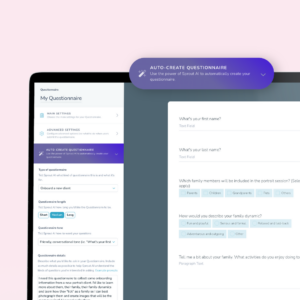You’re a photographer, but how do you get more people to know that?
Getting clients at the beginning of your career is relatively easy; you can work within your circle of influence (friends, family, acquaintances, and so on). At some point, though, that well will dry up. If you want clients in the long-term, you need to reach outside of your circle of influence.
That’s the role of marketing.
Marketing doesn’t have to be complicated. Marketing is simply the process of communicating to a specific group of people and making them aware of you and what you do.
Marketing is the process of communicating to a specific group of people and making them aware of you and what you do.
When most photographers start thinking about marketing, they think of tactics. They think of Facebook ads, bridal shows, magazine ads, and so on. That’s not what marketing is, though. That is simply a part of marketing, and in reality, it’s the last step.
It bears repeating. Marketing is the process of communicating to a specific group of people and making them aware of you and what you do.
Hidden in that loose definition of marketing are three key elements:
- Communicating
- Specific group of people
- You and what you do
Each of these represents a core pillar of marketing:
- Message, which is what you’re trying to say – who you are and what you do.
- Market, which is who you’re trying to say it to – the specific group of people.
- Medium, which is where and how you’ll say it; the actual act of communicating.

Herein lies the challenge – when you focus on just the medium (the Facebook ads, the bridal shows, and so on), you might be saying the wrong thing to the wrong people. Or, you may be saying the right thing to the wrong people or the wrong thing to the right people. When you focus on the medium first, you ignore the message and the market, and without intention there, your marketing will never work.
When you focus on just the medium, you might be saying the wrong thing to the wrong people.
That’s why a lot of photographers end up spinning their wheels with their marketing efforts and never quite get traction. They bounce from tactic to tactic and are always saying “this isn’t working.”
A lot of photographers eventually give up on marketing altogether.
But when you focus on building an intentional marketing strategy and follow the message, market, medium framework, your marketing is guaranteed to work. This framework also allows you to build a repeatable marketing machine that will catapult your business.
What’s the best way to go fishing?
When I was younger, we had a place up in Peterborough, Ontario where we’d spend a good part of the summer.
It was right on the water, and so there was a beach, docks with boats, a lagoon, and so on. It was very much your typical Canadian “up north” scene.
I loved to fish. The lake was full of perch, pickerel, pike, bass, catfish, musky and carp. With my fishing rod in one hand and my tackle box in the other, my friends and I would wander down to the docks to catch some fish.
If I’m honest, we didn’t know what we were doing – we were 14 years old, but we had fun! My friend would tell me about how he caught a bass the week before using this shiny new blue lure with nine different hooks on it, so I would try it out.
I would tell him about how I saw someone fishing recently with this lime green soft lure, and so my friend would try it out.
I remember we heard about this new fish scent oil that is supposed to act almost like a fish magnet, attracting the fish right to our lures. We bought a tube at the tackle shop and squeezed some onto our lures.

What did we catch? Well, most of the time … sunfish.
Small, tiny, inedible sunfish that were more annoying than anything.
Now and then we’d reel in a bass, and if we were lucky (usually when we went out in the boat), we’d catch a nice pickerel or snag a catfish.
Like I said, though, we didn’t know what we were doing. And that’s ok; it’s not like we were trying to bring home supper every night. When we did catch something, we would feel so accomplished, though! Being able to cook something that we caught that same day was incredibly fulfilling!
Fast-forward to when I was 20.
My girlfriend at the time (who is now my wife)’s Dad, Frank, was an avid fisherman.
When I first heard about this, I remembered those long days on the dock and thought “Oh, neat, I used to be a fisherman, too,” so I agreed to go out on the boat with him one Saturday morning.
I met him at his house at 6:15 am, well before the crack of dawn.
He had everything laid out and ready to go in his truck. I noticed in his boat; he had six fishing rods lined up, neatly organized in a rod holder. We stopped at the tackle shop before launching. He went in and came out less than a minute later, with a package of specialty minnows.
He launched the boat like clockwork, and we navigated out into the lake.
He had a GPS system, and he was constantly monitoring it as he steered right, then left, then right, then left. Now and then he would stop, check out his fish finder. Eventually, after an hour of driving out in the water, he stopped, and said: “let’s do this.”
I thought to myself, “Alright, let’s bait up some hooks and get these lines in the water,” but I was getting too far ahead of myself.
He spent the next 15 minutes meticulously setting up his 6 rods with the proper line, lures, sinkers, weights and so on. His tackle box looked like something out of a Martha Stewart craft store.
He had diving boards on each line, allowing him to specify the direction the line went. And he had a downrigger on each line, allowing him to specify how deep the lures went. It was quite the impressive setup! He set everything up with confidence, almost as if it was premeditated (it was).
He had six-rod holders that were all on a track. He could adjust how far up or down the boat they were, and they all had a pivot head so he could change the angle it held the rod. After he had put out the 6 rods in what seemed like a beautifully orchestrated display, he lowered his trolling motor, set the speed and direction with a remote control, sat back, grabbed his coffee and said: “now we wait.”
I was thinking to myself “Wait?! You mean we’re not going to be casting out the rods and reeling them in?”, recalling how I used to do it up north when I was younger.
I didn’t say anything, though, because he obviously knew his stuff.
In less than 5 minutes, we started getting bites on the lines. Eventually, we had bites on all six lines. Over the next several hours, we were reeling in fish after fish in rapid-fire motion.
We finished that day with what seemed like a hundred pickerel, and I mean big pickerel! Delicious pickerel! We had them for supper that night with the family, and then he filet’d the rest, put them into individual freezer bags for me to take home. We ended up getting 15 suppers out of the fish we caught that day.
Frank was a master fisherman. He knew his stuff. It almost made me feel silly to think about how I used to cast a line with some random lure, hoping a fish would swim and bite it at that exact moment. No wonder I would rarely catch anything, and no wonder every time Frank went out, he came back with a goldmine!
This story is very much about marketing.
Most photographers approach marketing with no purpose, no measured approach, no clue of what they’re going after and no plan on what they’re hoping to accomplish.
Most photographers are marketing like I was fishing up north on the docks. There’s no purpose, no measured approach, no clue of what they’re going after and no plan on what they’re hoping to accomplish. On top of that, they often use the wrong “bait” and choose the wrong approach.
Frank, on the other hand, knows exactly what he’s doing. He is measured and calculated. He has a purpose and an outcome. He knows what is appropriate to use to get that outcome, and he sets it up in a way that is repeatable and systematic.
You need to market like Frank fishes.
The small distinction in your marketing plan that makes all the difference
Look at the big picture of marketing in your business.
Marketing itself just describes all the things you are doing to market. The term “all of the things” refers to each marketing initiative or effort.
Making this distinction is important.
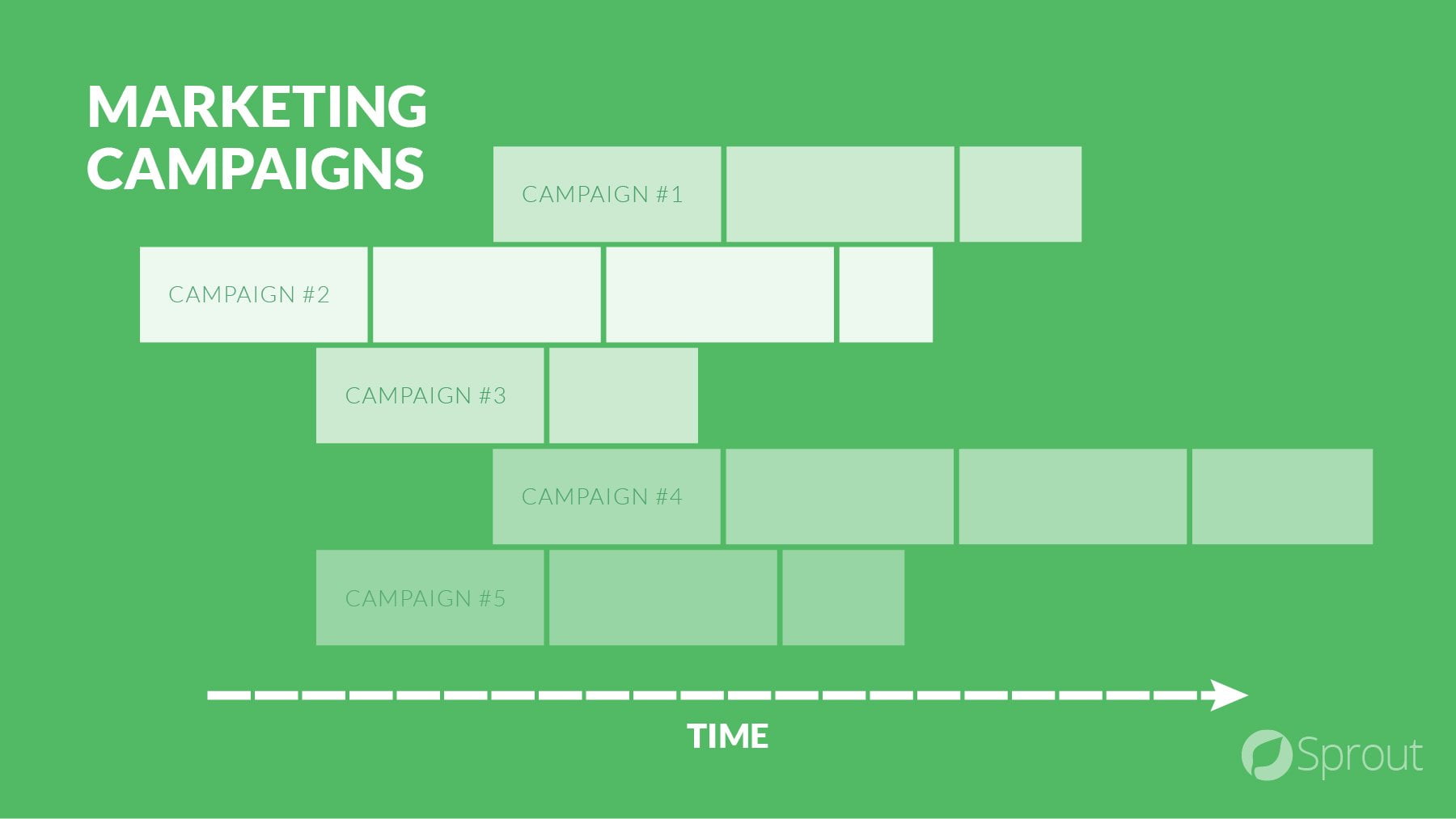
You must look at your marketing as a series of campaigns. Each campaign (or initiative) has a shelf-life and shouldn’t go on forever. You must look at each campaign to have its beginning and end. Each marketing campaign has its purpose, goals, objectives and a different approach.
Each marketing campaign will have its message, market, and medium. When you look at your marketing this way, it allows you to execute a very complex and powerful marketing plan for your business.
Each time Frank goes out fishing, he is going out for a different purpose. Therefore, he will use a different approach, a different set of lures, rods, methods, and so on.
Breaking out the big picture of marketing into individual marketing campaigns means you can run several campaigns at the same time. Each marketing campaign exists in its own “silo” with its plan.
If you don’t do this, your marketing will fail … guaranteed!
When planning and designing a marketing campaign, you must begin with the end in mind.
Before you start thinking about your message, you must define what you’re hoping to accomplish with your campaign.
[quoteright] When planning and designing a marketing campaign, you must begin with the end in mind.[/quoteright]
If you want people to respond immediately to an ad (i.e. a special deal or a limited time offer), you will message something completely different than if you were trying to build your brand and increase your awareness in the marketplace.
Before you start building out a marketing campaign, you need to define what your objectives are. There are three goals with marketing:
- Awareness, which shines a spotlight on your brand, but doesn’t necessarily attempt to elicit a specific immediate response. Therefore, the outcome of marketing for awareness has a greater long-term impact than it does a short-term impact.
- Direct-response, which calls the market to act. The goal with marketing for direct-response is to get someone to take action – click a link, call a phone number, download an eBook, sign up for a newsletter, and so on. The outcome for direct-response marketing has a greater short-term impact than it does a long-term impact.
- Relationships, which focuses on 1-to-1 relationship building. This is more on the “awareness” end of the spectrum with a focus on building high-quality relationships that may bring you some short-term results (because you are top-of-mind and are playing to the recency effect), but will most certainly bring you significant long-term results.
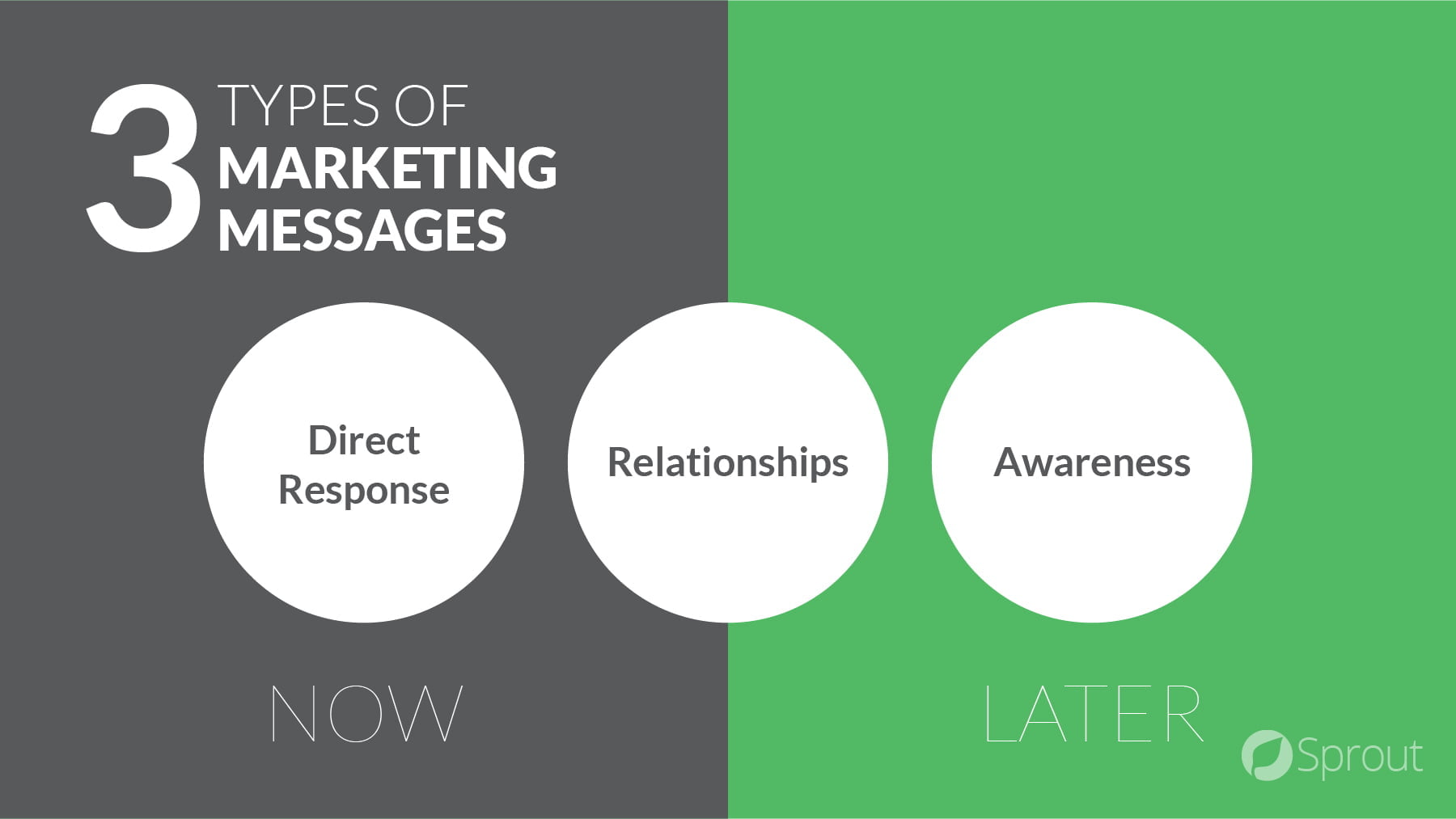
You must decide which of the three you’re going after when you start a marketing campaign. You cannot do more than one at the same time in the same campaign, although you can have several campaigns running, each with different objectives (i.e. you could certainly have an awareness campaign running at the same time as a direct response campaign).
Message – knowing what to say
Once you’ve defined what you’re hoping to accomplish with your marketing campaign, you must define what you want to say.
What is your message? What kind of impact do you want to have? What kind of emotion do you want to evoke?
If you confuse, you lose. You must choose a single message in each marketing initiative and stand by it.
Similar to how you must define your singular objective with each marketing campaign, I also advocate for defining a single message for each. If you confuse, you lose. You don’t want to overwhelm the market or try to be standing for too many things at the same time. Choose a single message and stand by it.
Come up with a few keywords that succinctly describe the message you’re trying to make and the stance you’re trying to take. Use those to extrapolate out a core value proposition. Use that value proposition and your keywords as a filter for everything you do in that campaign. The visuals you use, the photos you choose, the words you write and everything else must be tied back to those keywords and value proposition so that you have consistency in your messaging.
Understanding how you can communicate value
In defining your message and value proposition, you must consider how you can be communicating about the value you’re offering.
Remember, there is always an exchange of value whenever you “sell” anything. I’ve discussed the idea of the value vs. price scale many times, simplified into the “get give” principle, as I call it.
Everyone compares (often subconsciously) what they’re giving (usually money) vs. what they’re getting. If the value they’re getting is worth more than what they’re giving, they’re happy to give (pay) for it. If what they’re giving (paying) is more than the value they’re receiving, they will not want to give (pay) for it. This is often what happens when we hear “it’s too expensive” from a client – we simply didn’t build up the value enough for them.
When you’re defining and refining your message for a marketing campaign, consider how you can build up the value side of the exchange. I love this article that HBR researched and wrote, talking about the “elements of value,” which succinctly describes how people find value.
Most photographers often promote the quality of their imagery or something to do with the prettiness or aesthetic properties of their photography. Quality and sensory appeal are both on the bottom of the elements of value pyramid. While they contribute to the value your client receives, they are not the best way we can give value.
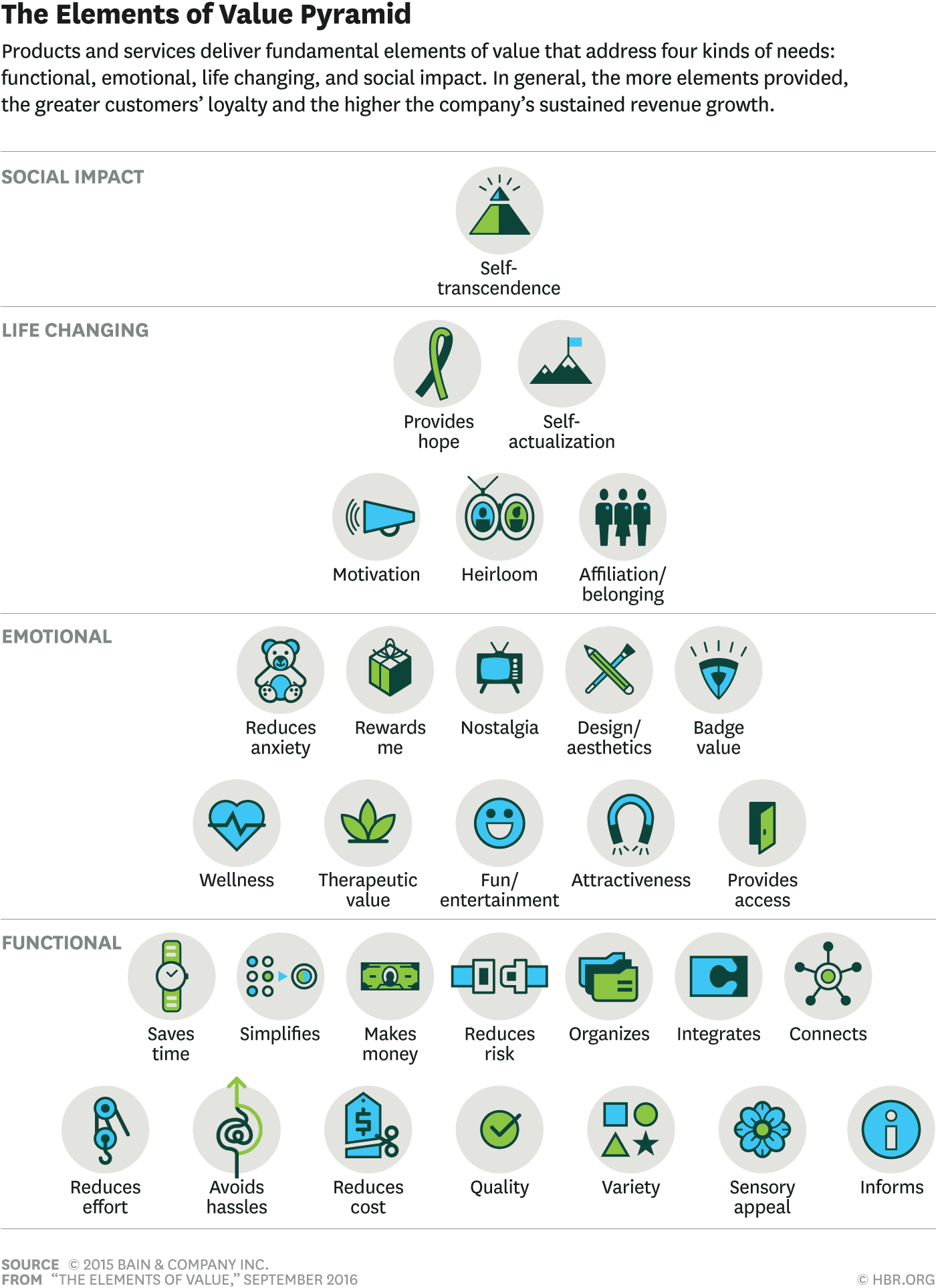
I suggest taking a look at the pyramid (which is modeled after Maslow’s hierarchy of needs) and try to identify how you can speak to the elements of value that are higher up on the pyramid. Perhaps you can speak to the fun/entertainment value (i.e. the experience you give), the therapeutic value that photography can give, the nostalgia that we can create through photography or the value of the heirloom we produce with our imagery.
Market – knowing who you’re talking to
Once you’ve identified your core value proposition and put language to it (your message), you can move on to defining your audience – the market.
You must take the time to think about who it is you’re trying to speak to. Not only do you want to consider demographic properties (male vs. female, how old they are, where they live, what kind of work they do, etc.), but you want to identify some psychographic properties as well. Think about what motivates them, what is important to them in their lives, what do they value in photography, and so on. You must also consider their awareness and understanding of you and your photography.
When you narrowly focus in on a very specific market, you can speak directly to them. In your marketing (and with your message), your audience should feel like you “get them” and are speaking 1-on-1 with them. The only way you can do this is by identifying who they are and then make sure that your message is tailored directly for them.
Frank knew we were going out fishing for pickerel. He chose everything based on that – the rods, the lures, the location, the approach and so on. Don’t be like me back on the dock up north – casting a line in the water and hoping for something to bite. If you do, you’ll either end up catching nothing or catching a bunch of what you don’t want (the sunfish).
Increasing your market velocity
When you’re defining your market, there is something I call market velocity, which is the speed and likelihood someone goes from a potential client to a paying client.
While the concept of a funnel is nothing new, it’s a perfect illustration of how marketing works. Every marketing campaign fills a proverbial funnel and gives you leads at the top. Through your sales process, you move those leads down through the funnel and some pop out as clients at the bottom.
[quoteright]Your marketing can increase your market velocity – the speed and likelihood someone goes from a potential client to a paying client.[/quoteright]
To increase your market velocity means to have more leads move down the funnel quicker and turn into clients more often. You can increase your market velocity by making sure you’re putting the right people at the top of the funnel, which highlights the importance of the “market” part of the marketing framework.
I define the “right people” as having three properties:
- Right fit – Someone who aligns with your core message, your beliefs and connect to your value proposition. This is why it’s important to refine message and market first and make sure they are consistent with each other.
- Right time – Someone who is primed and ready to buy, otherwise you’ll have to do a lot of nurturing while they’re in your sales process. Therefore, you must be sure you’re reaching the right people and talking to them in the right way.
- Right budget – Someone who is able (and ready) to pay for what you’re marketing to them. This isn’t a complete dealbreaker, though. If it’s right fit and the right time, you may be able to work on them with a proper value proposition, but at the same time, if they’re in a completely different ballpark, it may be more work than it’s worth, and they may never be ready to buy from you.
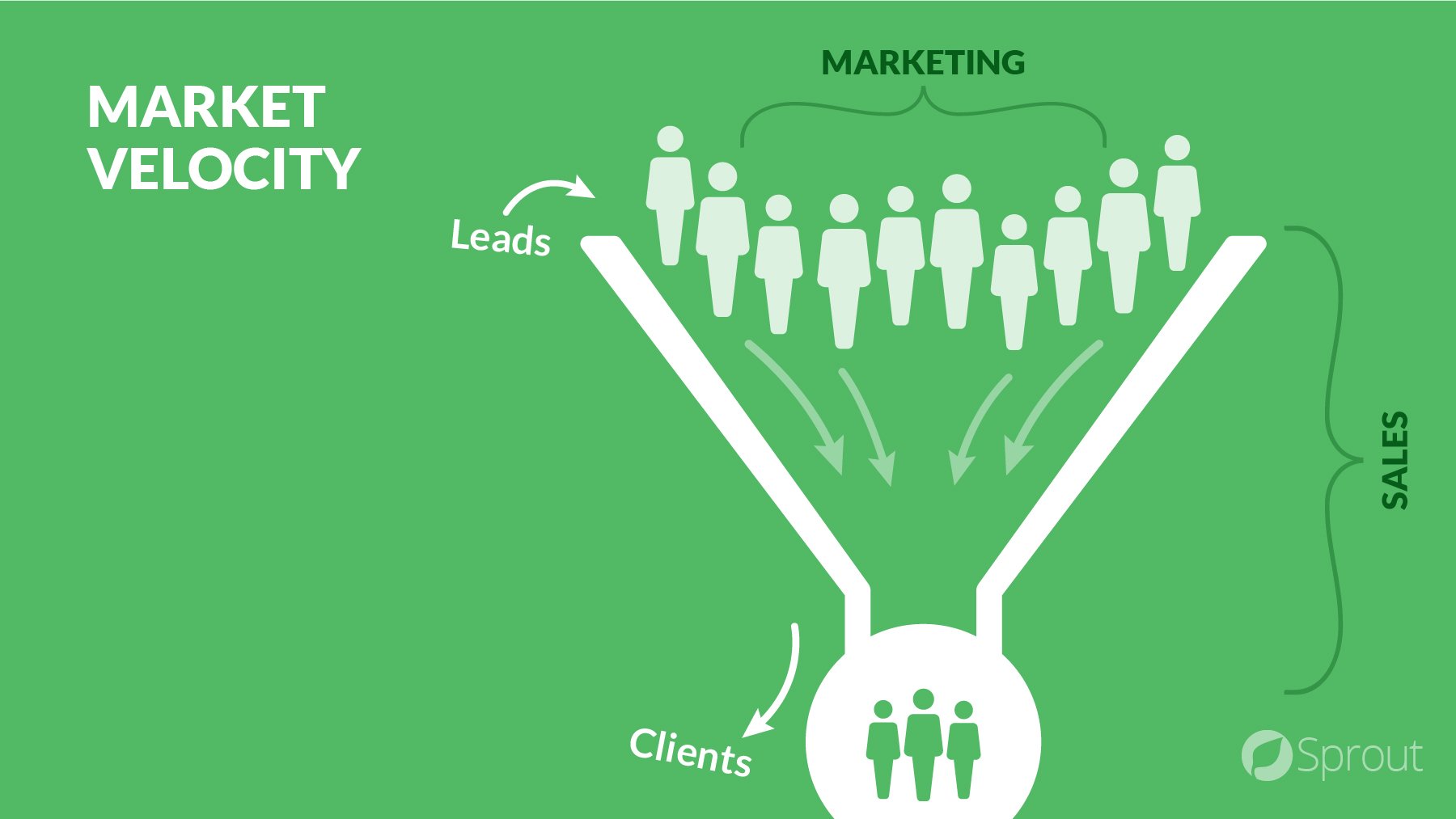
To increase market velocity and have more leads generated from marketing move down the funnel quicker and turn into clients more often, be sure to get the market right. By putting the right people with the right fit, timing, and budget into the top of your funnel with your marketing efforts, you’ll be able to accelerate the results from your marketing efforts.
Medium – choosing where and how you deliver your message to your market
Now we’re onto the medium; the tactics. The medium is simply the delivery vehicle for the message to the market.
See how long it took us to get here? I hope you see, now, why it’s so important to get the message and market right. Otherwise, you may be saying the wrong thing to the right people, the right thing to the wrong people, or the wrong thing to the wrong people. No wonder discussing or thinking about the medium can’t exist in a bubble!
There are two parts of the medium – where and how. The “where” defines the actual vehicle or tactic (i.e. Facebook ads, magazine ad, bridal show, etc.), and the “how” is the actual representation of the message (i.e. retargeting on Facebook, organic content, editorial coverage, etc.).
Here is a quick shortcut to figuring out how and where to reach the market you’ve defined with your message you’ve refined:
I’d like to tell who about what, with the goal of why. It’d be best to talk to them where by how.
In this equation:
- Who is the market
- What is the message
- Why is the objective or goal
- Where is the channel
- How is the specific tactic
This will help you define your medium.
It all starts with marketing
So – you want to get more people to know that you’re a photographer.
You want to get more high-quality clients who pay you more money and refer you more new clients who then pay you more money and refer you more new clients (repeat, repeat).
It all starts with marketing. Remember, getting clients at the beginning of your career is relatively easy; you can work within your immediate circle of influence. Eventually, though, that well dries up. Success in the long-term requires you to reach outside of that circle of influence.
… and that’s all marketing!
Refine your message, define your market and choose a medium to communicate the message to the market. Repeat this for every marketing initiative and you’re guaranteed to create a photography business that can scale and stand the test of time.













